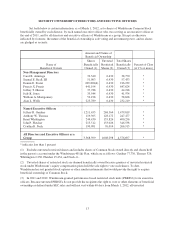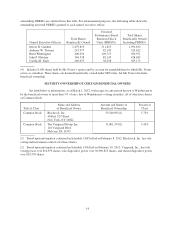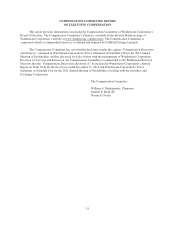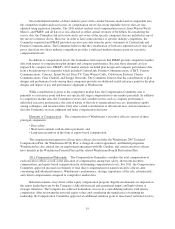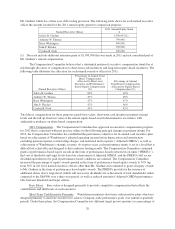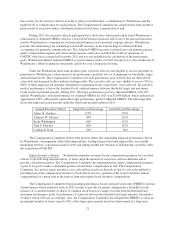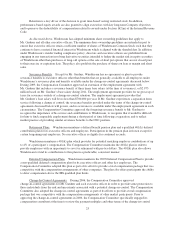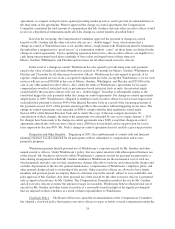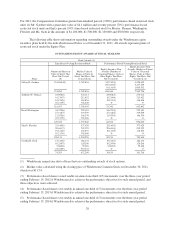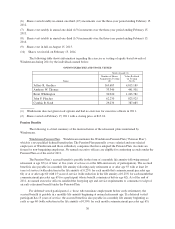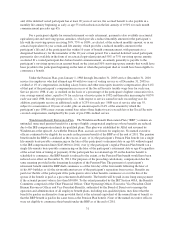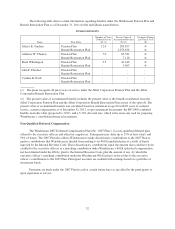Windstream 2011 Annual Report Download - page 29
Download and view the complete annual report
Please find page 29 of the 2011 Windstream annual report below. You can navigate through the pages in the report by either clicking on the pages listed below, or by using the keyword search tool below to find specific information within the annual report.
Retention is a key driver of the decision to grant time-based vesting restricted stock. In addition,
performance-based equity awards are also granted to align executives with key long-term Company objectives
and to preserve the deductibility of compensation related to awards under Section 162(m) of the Internal Revenue
Code.
As discussed above, Windstream has adopted minimum share ownership guidelines that apply to
Mr. Gardner and all other executive officers. The minimum share ownership guidelines are intended in part to
ensure that executive officers retain a sufficient number of shares of Windstream Common Stock such that they
continue to have a material financial interest in Windstream which is aligned with the shareholders. In addition,
under Windstream’s insider trading compliance policy, directors and executive officers are prohibited from
engaging in any transaction involving derivative securities intended to hedge the market risk in equity securities
of Windstream other than purchases of long call options or the sale of short put options that are not closed prior
to their exercise or expiration date. The policy also prohibits the purchase of shares on loan or margin and short
sales.
Severance Benefits. Except for Mr. Gardner, Windstream has no agreement or plan to provide
severance benefits to executive officers other than benefits that are generally available to all employees under
Windstream’s severance plan and benefits available under the change-in-control agreements discussed below.
During 2009, the Compensation Committee approved an extension of the employment agreement with
Mr. Gardner that includes a severance benefit of three times base salary (at the time of severance), or $2.973
million based on Mr. Gardner’s base salary during 2011. The employment agreement provides for no gross up of
taxes for severance outside of a change-in-control situation. The employment agreement provides that
Mr. Gardner’s base salary will be no less than $700,000 per year. If Mr. Gardner experiences a separation from
service following a change of control, the severance benefits provided under the terms of the change-in-control
agreements discussed below will govern, and no severance is available under the employment agreement in such
circumstance. The Compensation Committee approved the foregoing severance benefit to Mr. Gardner to
recognize the importance of his service and contributions to Windstream, to recognize that it would be difficult
for him to find comparable employment during a short period of time following a separation, and to reflect
market practice of providing similar severance benefits to the CEO position.
Retirement Plans. Windstream maintains a defined benefit pension plan and a qualified 401(k) defined
contribution plan for its executive officers and employees. Participation in the pension plan is frozen except for
certain bargaining unit employees. No executive officer is eligible for continued accruals.
Windstream maintains a 401(k) plan which provides for potential matching employer contributions of up
to 4% of a participant’s compensation. The Compensation Committee maintains the 401(k) plan in order to
provide employees with an opportunity to save for retirement with pre-tax dollars. The 401(k) plan also allows
Windstream to fund its contributions to this plan in a predictable, consistent manner.
Deferred Compensation Plans. Windstream maintains the 2007 Deferred Compensation Plan to provide
a non-qualified deferred compensation plan for its executive officers and other key employees. The
Compensation Committee adopted this plan as part of its effort to provide a total compensation package that was
competitive with the compensation arrangements of other companies. The plan also offers participants the ability
to defer compensation above the IRS qualified plan limits.
Change-In-Control Agreements. During 2006, the Compensation Committee approved
change-in-control agreements for Mr. Gardner and each executive officer in order to provide some protection to
those individuals from the risk and uncertainty associated with a potential change-in-control. The Compensation
Committee also adopted the change-in-control agreements as part of its efforts to provide a total compensation
package that was competitive with the compensation arrangements of other market participants. Prior to
approving the change-in-control agreements in 2006, the Compensation Committee specifically engaged its
compensation consultant at the time to review the payment multiples and other terms of the change-in-control
23


